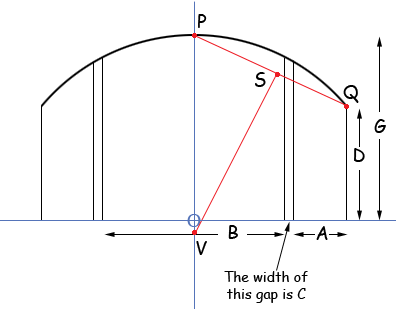 |
 |
|
I need to calculate Dimension E and F. I am given A, B, C, (or over all A+B+C), D, G. The radius is one continuous unknown radius.
|
|
Hi Kaye, I redrew the diagram you sent based on out email conversation, and labeled some points.
I drew a coordinate axis with the origin at O, the midpoint of the line of length B. V is the centre of the circle and lies of the y-axis. Since P and Q are on the circle the centre must lie on the right bisector of the line segment PQ. Hence I am going to find the equation of this right bisector and see where it crosses the y-axis. This will give me the centre and radius of the circle from which you should be able to determine the other dimensions you need. P has coordinates (0,G) and Q has coordinates ( B/2 + C + A, D) and hence S the midpoint of PQ has coordinates
The line through P and Q has slope
and thus the right bisector of the line segment PQ has slope
Thus the right bisector of the line segment PQ has equation
This line intersects the y-axis at V which has x-coordinate 0 so the y-coordinate of V is
With the example dimensions you sent I got V to have coordinates (0, -55.12) and hence the radius of the circle is 23.5 + 55.1 = 78.6". Harley |
 |
 |
 |
